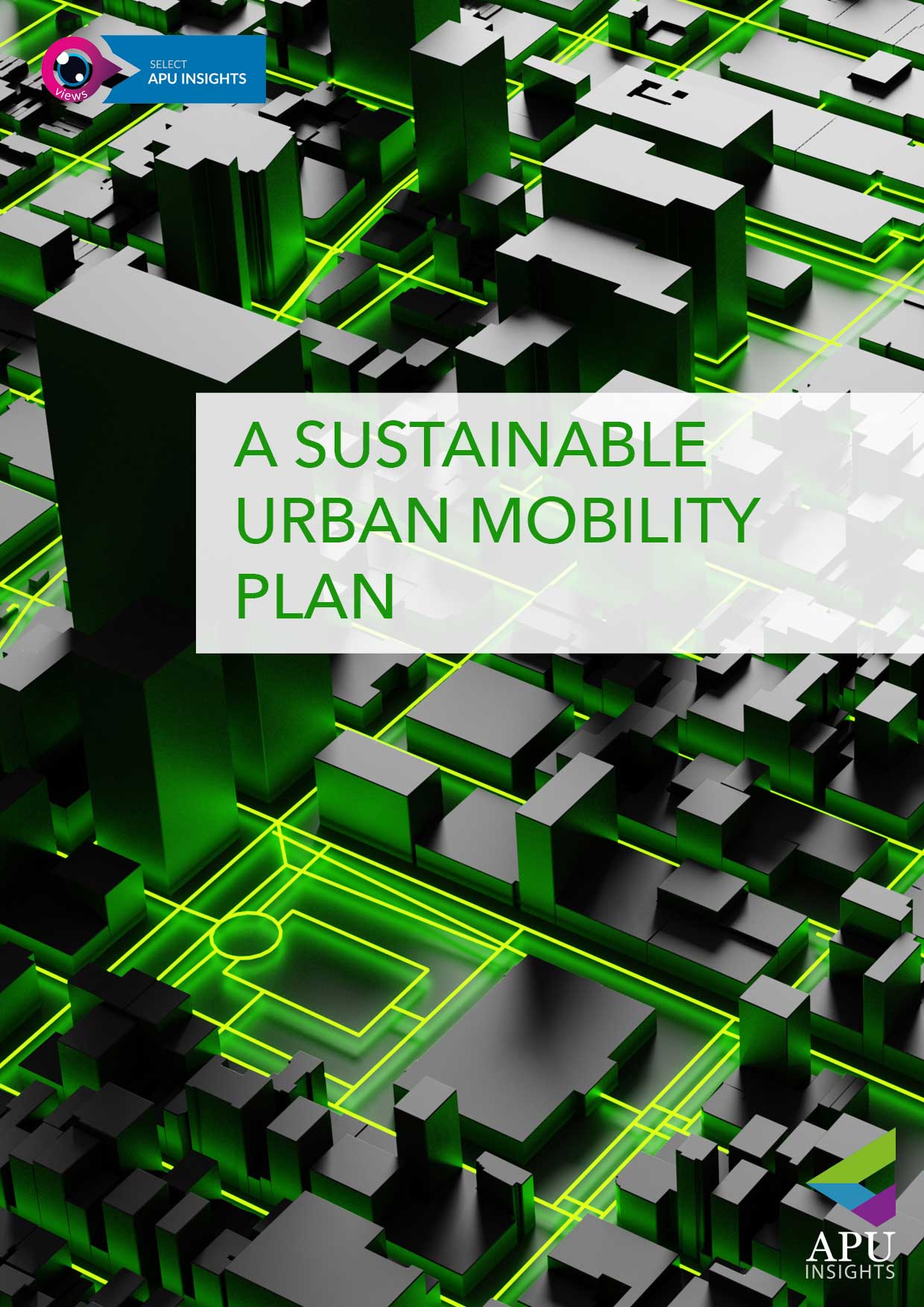A Sustainable Urban Mobility Plan
Dr. Evangelo Damigos; PhD | Head of Digital Futures Research Desk
- Connected Intelligence
- Sustainable Growth and Tech Trends
Publication | Update: Sep 2020

A Sustainable Urban Mobility Plan fosters a balanced and integrated development of all relevant transport modes, while supporting the shift towards sustainable mobility. According to Rupprecht Consult -Forschung & Beratung GmbH, editor of “Guidelines for Developing and Implementing a Sustainable Urban Mobility Plan,” over the last few years we have seen major new developments in many areas of urban mobility: due to new technologies driverless electric vehicles may soon be on our roads, new business models provide “Mobility as a Service”, and at the same time changing attitudes among travellers result in an increase in shared mobility and cycling.
What Makes a Sustainable Transport System in Cities
Moving millions of people from one place to the next sustainably is not easy — strategic planning and good urban design is a must for all cities to ensure sustainable transportation systems.
Below we highlight a number of initiatives that could revolutionize the transport sector: automated driverless rideshare networks, digitally enabled e-bikes, to the use of big data in transport networks that enable people to have real-time information about public transport networks. An example of such an application is Citymapper which uses open real-time data to help commuters navigate the fastest route/mode of transport to get them from one place to another. Other smart mobility solutions include integrated traffic control systems that can cut both peak-hour congestion and accident rates and on-street smart parking management that can enable better use of city parking assets.

We have highlighted a number of examples where cities have invested in or are investing in a variety of transport measures to reduce the use of private cars, improve air quality and reduce congestion in the city. A reduction in travel intensity in cities through higher urban densities, greater physical proximity, and a co-location of urban functions would allow easier deployment of sustainable transport systems in cities.
A good example is Hong Kong where over 41% of the population lives within half a mile of a metro station and public transportation is used by the majority of people. In comparison cities such as Atlanta and Houston have a higher per capita usage of cars due to their sprawling nature. Investments in capital intensive projects should also be future proof — this is important given that new technologies such as autonomous cars could change the very nature of a city requiring less space for parking and easier mobility for people, while the increase in electric cars would require investment in public charging stations.
Ease of use of public transport networks is also a must.
A good example is the Oyster card in London which is a smart card which commuters can use on all public transport networks including bus service, inter-rail, and the tube service.
The system now also allows payment with contactless bank cards on all services. Cities should leverage big data to understand the transport network better, to design more efficient services, and to predict future travel in the city.
Urban mobility is described as the lifeblood of modern cities, a critical economic factor, and a facilitator of smart, sustainable development.
“A Sustainable Urban Mobility Plan is a strategic plan designed to satisfy the mobility needs of people and businesses in cities and their surroundings for a better quality of life. It builds on existing planning practices and takes due consideration of integration, participation, and evaluation principles.”
A Sustainable Urban Mobility Plan is based on the following principles:
1.Plan for sustainable mobility in the 'functional city'
2.Cooperate across institutional boundaries
3.Involve citizens and stakeholders
4.Assess current and future performance
5.Define a long-term vision and a clear implementation plan
6.Develop all transport modes in an integrated manner
7.Arrange for monitoring and evaluation
8.Assure quality

The 12 Steps of Sustainable Urban Mobility Planning (SUMP 2.0) –A decision maker's overview
The Sustainable Urban Mobility Plan typically addresses all forms of collective mobility (traditional public transport as well as new services based on sharing, including new business models), active mobility (walking and cycling), intermodality and door-to-door mobility, traffic safety, moving and stationary transport, freight and service delivery, logistics, mobility management, and Intelligent Transport Systems (ITS).
 Digital Themes: Connected Intelligence, Sustainable Growth and Tech Trends
Digital Themes: Connected Intelligence, Sustainable Growth and Tech Trends

HTML
 Access Rights | Content Availability:
Access Rights | Content Availability: 


Objectives and Study Scope
This study has assimilated knowledge and insight from business and subject-matter experts, and from a broad spectrum of market initiatives. Building on this research, the objectives of this market research report is to provide actionable intelligence on opportunities alongside the market size of various segments, as well as fact-based information on key factors influencing the market- growth drivers, industry-specific challenges and other critical issues in terms of detailed analysis and impact.
The report in its entirety provides a comprehensive overview of the current global condition, as well as notable opportunities and challenges.
The analysis reflects market size, latest trends, growth drivers, threats, opportunities, as well as key market segments. The study addresses market dynamics in several geographic segments along with market analysis for the current market environment and future scenario over the forecast period.
The report also segments the market into various categories based on the product, end user, application, type, and region.
The report also studies various growth drivers and restraints impacting the market, plus a comprehensive market and vendor landscape in addition to a SWOT analysis of the key players.
This analysis also examines the competitive landscape within each market. Market factors are assessed by examining barriers to entry and market opportunities. Strategies adopted by key players including recent developments, new product launches, merger and acquisitions, and other insightful updates are provided.
Research Process & Methodology

We leverage extensive primary research, our contact database, knowledge of companies and industry relationships, patent and academic journal searches, and Institutes and University associate links to frame a strong visibility in the markets and technologies we cover.
We draw on available data sources and methods to profile developments. We use computerised data mining methods and analytical techniques, including cluster and regression modelling, to identify patterns from publicly available online information on enterprise web sites.
Historical, qualitative and quantitative information is obtained principally from confidential and proprietary sources, professional network, annual reports, investor relationship presentations, and expert interviews, about key factors, such as recent trends in industry performance and identify factors underlying those trends - drivers, restraints, opportunities, and challenges influencing the growth of the market, for both, the supply and demand sides.
In addition to our own desk research, various secondary sources, such as Hoovers, Dun & Bradstreet, Bloomberg BusinessWeek, Statista, are referred to identify key players in the industry, supply chain and market size, percentage shares, splits, and breakdowns into segments and subsegments with respect to individual growth trends, prospects, and contribution to the total market.
Research Portfolio Sources:
Global Business Reviews, Research Papers, Commentary & Strategy Reports
M&A and Risk Management | Regulation

The future outlook “forecast” is based on a set of statistical methods such as regression analysis, industry specific drivers as well as analyst evaluations, as well as analysis of the trends that influence economic outcomes and business decision making.
The Global Economic Model is covering the political environment, the macroeconomic environment, market opportunities, policy towards free enterprise and competition, policy towards foreign investment, foreign trade and exchange controls, taxes,
financing, the labour market and infrastructure.
We aim update our market forecast to include the latest market developments and trends.
Review of independent forecasts for the main macroeconomic variables by the following organizations provide a holistic overview of the range of alternative opinions:
As a result, the reported forecasts derive from different forecasters and may not represent the view of any one forecaster over the whole of the forecast period. These projections provide an indication of what is, in our view most likely to happen, not what it will definitely happen.
Short- and medium-term forecasts are based on a “demand-side” forecasting framework, under the assumption that supply adjusts to meet demand either directly through changes in output or through the depletion of inventories.
Long-term projections rely on a supply-side framework, in which output is determined by the availability of labour and capital equipment and the growth in productivity.
Long-term growth prospects, are impacted by factors including the workforce capabilities, the openness of the economy to trade, the legal framework, fiscal policy, the degree of government regulation.
Direct contribution to GDP
The method for calculating the direct contribution of an industry to GDP, is to measure its ‘gross value added’ (GVA); that is, to calculate the difference between the industry’s total pretax revenue and its total boughtin costs (costs excluding wages and salaries).
Forecasts of GDP growth: GDP = CN+IN+GS+NEX
GDP growth estimates take into account:

Market Quantification
All relevant markets are quantified utilizing revenue figures for the forecast period. The Compound Annual Growth Rate (CAGR) within each segment is used to measure growth and to extrapolate data when figures are not publicly available.
Revenues
Our market segments reflect major categories and subcategories of the global market, followed by an analysis of statistical data covering national spending and international trade relations and patterns. Market values reflect revenues paid by the final customer / end user to vendors and service providers either directly or through distribution channels, excluding VAT. Local currencies are converted to USD using the yearly average exchange rates of local currencies to the USD for the respective year as provided by the IMF World Economic Outlook Database.
Industry Life Cycle Market Phase
Market phase is determined using factors in the Industry Life Cycle model. The adapted market phase definitions are as follows:

The Global Economic Model
The Global Economic Model brings together macroeconomic and sectoral forecasts for quantifying the key relationships.
The model is a hybrid statistical model that uses macroeconomic variables and inter-industry linkages to forecast sectoral output. The model is used to forecast not just output, but prices, wages, employment and investment. The principal variables driving the industry model are the components of final demand, which directly or indirectly determine the demand facing each industry. However, other macroeconomic assumptions — in particular exchange rates, as well as world commodity prices — also enter into the equation, as well as other industry specific factors that have been or are expected to impact.
Forecasts of GDP growth per capita based on these factors can then be combined with demographic projections to give forecasts for overall GDP growth.
Wherever possible, publicly available data from official sources are used for the latest available year. Qualitative indicators are normalised (on the basis of: Normalised x = (x - Min(x)) / (Max(x) - Min(x)) where Min(x) and Max(x) are, the lowest and highest values for any given indicator respectively) and then aggregated across categories to enable an overall comparison. The normalised value is then transformed into a positive number on a scale of 0 to 100. The weighting assigned to each indicator can be changed to reflect different assumptions about their relative importance.

The principal explanatory variable in each industry’s output equation is the Total Demand variable, encompassing exogenous macroeconomic assumptions, consumer spending and investment, and intermediate demand for goods and services by sectors of the economy for use as inputs in the production of their own goods and services.
Elasticities
Elasticity measures the response of one economic variable to a change in another economic variable, whether the good or service is demanded as an input into a final product or whether it is the final product, and provides insight into the proportional impact of different economic actions and policy decisions.
Demand elasticities measure the change in the quantity demanded of a particular good or service as a result of changes to other economic variables, such as its own price, the price of competing or complementary goods and services, income levels, taxes.
Demand elasticities can be influenced by several factors. Each of these factors, along with the specific characteristics of the product, will interact to determine its overall responsiveness of demand to changes in prices and incomes.
The individual characteristics of a good or service will have an impact, but there are also a number of general factors that will typically affect the sensitivity of demand, such as the availability of substitutes, whereby the elasticity is typically higher the greater the number of available substitutes, as consumers can easily switch between different products.
The degree of necessity. Luxury products and habit forming ones, typically have a higher elasticity.
Proportion of the budget consumed by the item. Products that consume a large portion of the
consumer’s budget tend to have greater elasticity.
Elasticities tend to be greater over the long run because consumers have more time to adjust their behaviour.
Finally, if the product or service is an input into a final product then the price elasticity will depend on the price elasticity of the final product, its cost share in the production costs, and the availability of substitutes for that good or service.
Prices
Prices are also forecast using an input-output framework. Input costs have two components; labour costs are driven by wages, while intermediate costs are computed as an input-output weighted aggregate of input sectors’ prices. Employment is a function of output and real sectoral wages, that are forecast as a function of whole economy growth in wages. Investment is forecast as a function of output and aggregate level business investment.




 Industry: Government and Smart Cities
Industry: Government and Smart Cities 
